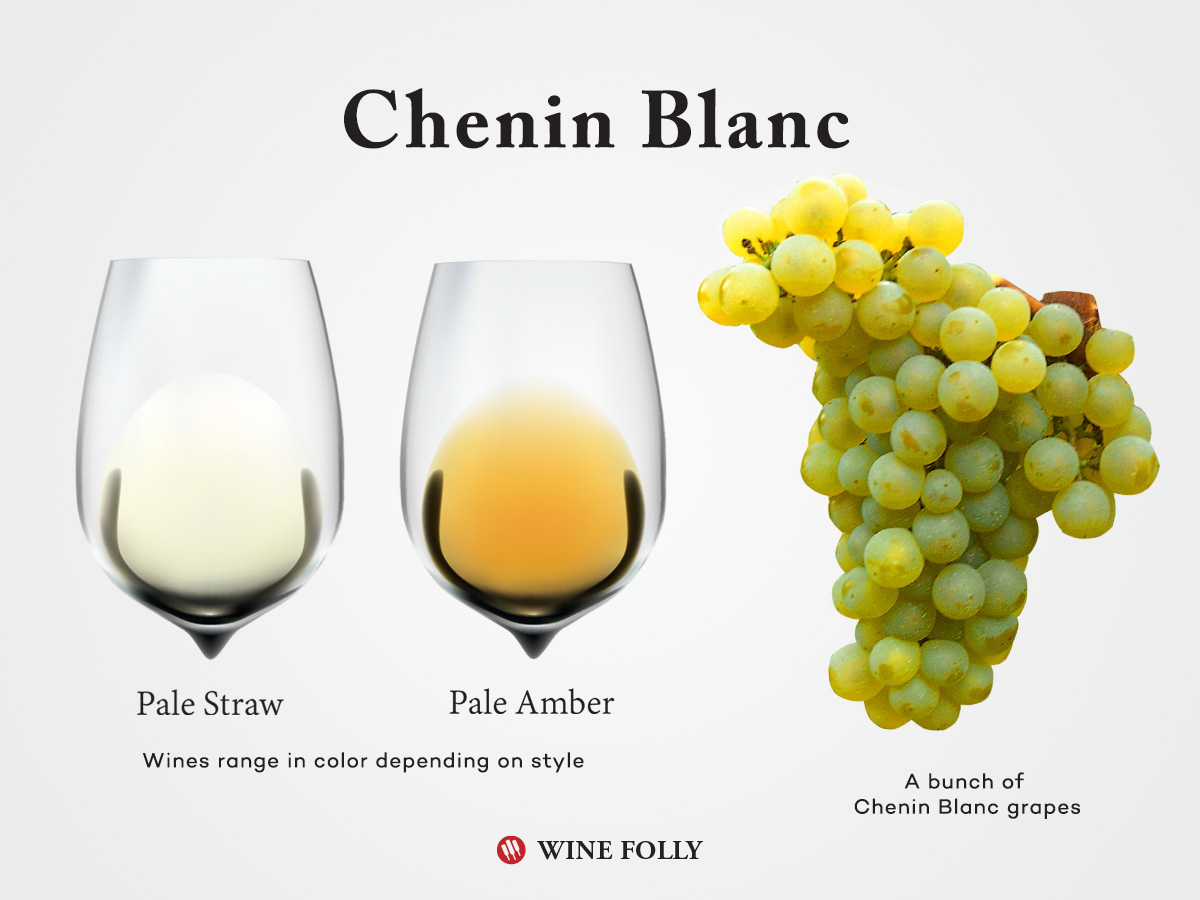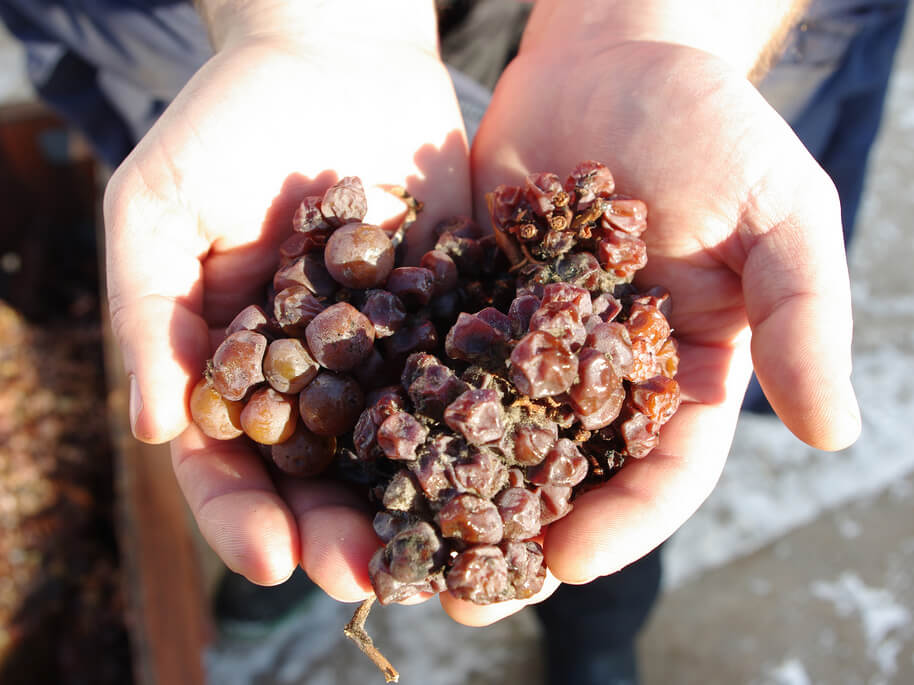Also known as: Steen, Pineau
Table of Contents
Primary Flavors
- Quince
- Yellow Apple
- Pear
- Chamomile
- Honey
Taste Profile
Chenin Blanc can produce a wide range of flavors as a white grape. Part of this has a lot to do with the winemaking style. You’ll find a range of flavors, from sparkling to oaked and unoaked dry white wines, and even sweet wines. However, all the wines made from Chenin will have similarities.
On the nose, Chenin Blanc often shows distinctive quince, apple, or apple skin aromas. Depending on whether the grapes are picked later in the season or even if they undergo Noble Rot, you can expect to find ripe pineapple, orange peel, honey, and dried chamomile.
On the palate, Chenin Blanc delivers high levels of zingy acidity no matter the style. It’s like Riesling’s acidity meets Chardonnay’s body and texture. Wines range from bone dry to lusciously sweet, light-bodied to unctuous and creamy. Few grapes have such an expanse of flavors and styles as Chenin Blanc.
How to Serve Chenin Blanc Wine
Generally, Chenin Blanc should be served cold, no matter the style. This is especially true with the sparkling and sweet styles. If you find yourself with an oaked Chenin Blanc, it can be served a bit warmer, like you would serve a Chardonnay.
A white wine glass is perfect even for sparkling versions. Some of the finest examples of Chenin Blanc from the Loire and South Africa, especially the sweet wines, can age for many years, but in most cases, you won’t have to decant.

SERVE
45–55°F / 7-12°C
GLASS TYPE
White
DECANT
No
CELLAR
10+ Years
Chenin Blanc Food Pairing
Thanks to Chenin Blanc’s awesome acidity and subtle apple and quince flavors, it pairs well with foods with a sweet and sour element. Southeast Asian cuisine, or pork belly with apples, paired with a richer and sweeter style of Chenin Blanc, will blow your mind.
Oaked versions are the perfect substitute for Chardonnay and work well with roast chicken or turkey dinners. Sparkling Chenin Blancs are the perfect aperitif, and that racy acid pairs well with salted nuts and potato chips.

5 Fun Facts About Chenin Blanc
- Named after Mont Chenin, the grape’s origins date back to the 9th-century Loire Valley.
- South African “Steen” was once misidentified as a Palomino mutation.
- Tartaric acid imbues Chenin Blanc with high acidity and aging potential.
- Uneven ripening within a cluster leads to varying sugar levels at harvest.
- Volatile thiols impart signature honeyed and beeswax aromas in Chenin Blanc.

Where it Grows
Despite its French origins, 55% of all Chenin Blanc in the world is planted in South Africa, and just 30% is grown in France.
- South Africa: 43,755 acres (17,707 hectares)
- France: 23,307 (9,432 hectares)
- Argentina: 5,330 acres (2,157 hectares)
- USA: 4,866 acres (1,969 hectares)
Total Vineyard Area – 79,620 acres (32,221 hectares) (Source: University of Adelaide, 2021)

South Africa
What to expect: South African Chenin Blanc, known locally as “Steen,” offers a diverse range of styles that showcase the grape’s versatility, from sparkling, bone dry, and even sweet wines. Here are the main styles and what to expect from each.
Crisp and refreshing: Found in cooler coastal regions like Elgin and Walker Bay, these wines offer green apple, pear, and citrus flavors with zesty acidity.
Rich and full-bodied: Swartland and Paarl regions produce Chenin Blancs with tropical flavors like peach, apricot, and mango, along with a fuller body.
Oak-aged: Stellenbosch and Franschhoek boast Chenin Blancs with baked apple, caramel, and buttery notes, complemented by well-integrated oak influences.
Sweet Wines: Constantia delivers Chenin Blancs featuring apricot, candied orange peel, and fig flavors, with rich sweetness balanced by vibrant acidity.
Cap Classique (sparkling): Stellenbosch, Franschhoek, and Robertson regions offer sparkling Chenin Blancs with flavors of green apple, lemon, and subtle yeasty notes, supported by lively acidity and delicate bubbles.
Loire Valley, France
What to expect: The Loire Valley, the birthplace of Chenin Blanc, also offers many different styles, and these tend to be leaner and perhaps more mineral than some of their South African counterparts.
Crisp and refreshing: Found in regions like Anjou, these wines showcase flavors of green apple, lemon, and white flowers, with high acidity and a mineral-driven finish.
Rich and full-bodied: Vouvray produces off-dry (demi-sec) to sweet Chenin Blancs with flavors of quince, honey, and ripe pear, along with a fuller body and balanced acidity.
Oak-aged: Savennières is known for complex, oak-aged Chenin Blancs, offering baked apple, hazelnut, and beeswax notes, complemented by a savory, mineral character. These can age for decades.
Sweet Wines: Coteaux du Layon, Bonnezeaux, and Quarts de Chaume deliver botrytis-affected Chenin Blancs featuring flavors of apricot, honeycomb, and candied lemon, with luscious sweetness balanced by bright acidity.
Sparkling wines (Crémant de Loire): Saumur and other Loire regions produce traditional method sparkling Chenin Blancs, with flavors of green apple, citrus, and brioche, supported by lively acidity and delicate bubbles.

In-Depth Knowledge
Take a deep dive into understanding how Chenin Blanc can produce wines with varying sugar levels and textures, yet always has refreshingly high acidity.
Laser Sharp Acidity
The high acidity levels in Chenin Blanc, determined by its genetic predisposition and terroir, give the wine a crisp, refreshing taste and a well-balanced structure. This trait can be traced back to the grape’s genetic predisposition for producing high levels of tartaric and malic acids. These organic acids are formed during the grapevine’s metabolic processes and contribute to the wine’s overall taste, structure, and age-worthiness.
Tannin
Phenolic compounds, responsible for the wine’s color, astringency, and antioxidant properties, play a crucial role in the mouthfeel and overall taste of Chenin Blanc. These compounds, which include flavonoids, phenolic acids, and tannins, are synthesized within the grapevine through a series of enzymatic reactions.
The presence of these compounds contributes to the wine’s diverse flavor profile, which may include notes of quince, apple, pear, honey, and even a touch of minerality, depending on the specific wine style. The astringency, derived from tannins and other phenolic compounds, can impart a pleasant texture to the wine, enhancing its complexity and ability to pair with various foods.
Different Sugar Levels
Chenin Blanc is considered an uneven ripening grape primarily due to its inherent genetic traits and sensitivity to environmental factors. Its tendency to develop a millerandage, a condition where grape clusters contain berries of different sizes and developmental stages, contributes to this uneven ripening.
Thankfully, this uneven ripening can be used to make different styles of wine, from bone dry to off-dry and, if some berries undergo noble rot, even dessert wines.
Noble Rot
Chenin Blanc is particularly susceptible to Botrytis cinerea due to its thin skin and propensity to retain moisture. The grape’s high acidity and naturally high sugar content create a favorable environment for the fungus to thrive, leading to the development of noble rot when conditions are optimal, such as in cool, humid conditions with morning mists followed by warm, sunny afternoons.